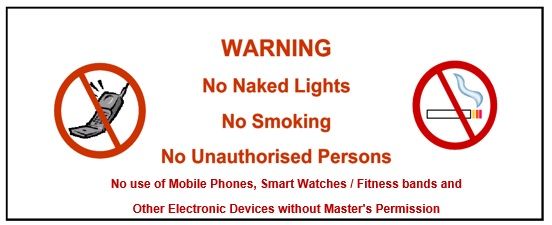The gangways are manned by a watchman who is responsible to the SSO or OOW.
Primary responsibility of a Gangway Watchman
- to control access to the ship,
- control of people and equipment to and from the vessel,
- searching of personnel and/or baggage,
- reporting of security incidents or breaches.
Additionally, Gangway watchman must be trained for below
- Gangway access point ALWAYS MUST BE MANNED.
- If somebody from ship’s staff call for another duty, must be sure, that reliever is available at the gangway. Those on gangway duty must not leave the station until properly relieved. Gangways are not left unattended at any time for whatever reason until a relief has been briefed and taken over responsibility.
- The gangway must be checked to see that it is properly lashed and secured, well lit and at all times safe for use. The embarkation area should be kept orderly and clean at all times. The first impression is the one that lasts.
- Control of permitted persons and goods:
- At access point, all pre-allowed visitors and joining crew boarding the vessel must have their identity checked
- names, time in and out and purpose of visit recorded in gangway book
- been escorted to and from their point of interest if deemed necessary by SSO
- be liable to search if deemed necessary by the SSO and at random in a ratio: 1 to 10
- GIVEN ID badges, when the person leaving must return ID badge All persons must sign the log on and off the boat, legibly and in ink.
- instructed to avoid restricted areas
- IF REFUSING to show ID or explain reasons for boarding then DETAINED and reported to SSO
- If showing suspicious behaviour, DETAINED at the access point for further investigation by the SSO
- Bags or goods carried inconsistent with visitor purpose and at random in ratio of 1 to 10 opened for inspection
- A watch shall be maintained for unauthorised removal of the ship’s equipment and stores.
- An alert watch is kept at all times at the head of each gangway. This is to include careful scrutiny of the quayside area and, in particular, any movements of personnel in the areas of open shell doors and mooring lines fore and aft.
- No unaccompanied baggage is permitted on the vessel or to be left in the immediate vicinity of the gangway.
- Gangway access point must be equipped with spare, freshly charged battery for the walkie-talkie.
- Gangway access point must be equipped with a box containing minimum 4 helmets, 2 eye safety gear (goggles) 2 pair of gloves for the visitor.
- Gangway access point must be equipped with instructions concerning patrolling pattern, locking system and body search procedure.
- Always report to OOW any abnormal situations especially around the vessel and insight.
- The SSO or OOW is informed immediately of any instance of persons boarding or leaving the ship other than by the gangway, i.e., leaping over bulwarks, from decks of stacked vessels, or thru side gates, etc.
- In the case of emergency alarms, watchman must remain on gangway access point until further orders obtained from OOW, SSO or Master.
ISPS code – A measure to enhance the security of Ships and Port facilities
In the event of an emergency situation, gangway watchmen should, without jeopardising their own safety, alert the SSO or OOW then direct the Master, and other relevant officers as appropriate.
An Example of a Gangway Notice as displayed on a Tanker vessel

Gangway Notice

Very good, I found this very useful for myself. I have just started work as a gangway watchman 4 days ago, I hope to get more of this informational training ahead God willing please do more, thanks.
What are the duties of gangway watch in ports and Anchorage?
Gangway watch duty
1 ensure safety net on gangway
2 Roller ,stanchion,side rope ,main rope to be check
3 Reporting off security incident
4 serching off personal and baggegr .according to the security level
5 Report all the movement to the oow etc
Thanks for explaining how those assigned for duty on a gangway should not leave their station until properly relieved and gangways should never be left unattended. I would imagine that the safety of a gangway would also be an important safety measure to consider when operating on one. A professional inspection would ensure that a gangway would be safe for ships.
This post offers a great overview of the vital role a gangway watchman plays on merchant ships. It’s interesting to see how their duties extend beyond just security, ensuring safety and communication too. Thanks for shedding light on this often overlooked position!
Great insights on the responsibilities of a gangway watchman! It’s interesting to see how crucial their role is in ensuring safety and security on merchant ships. The detailed descriptions help highlight the importance of their vigilance and the challenges they face. Thanks for sharing this informative post!